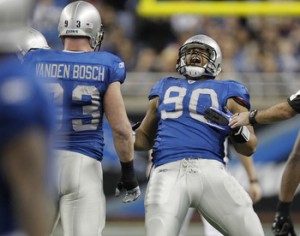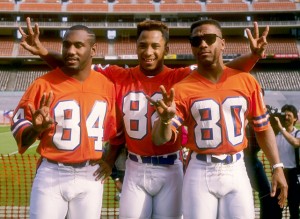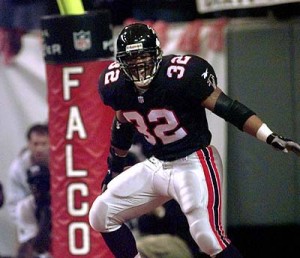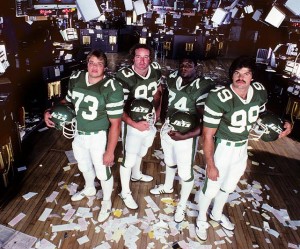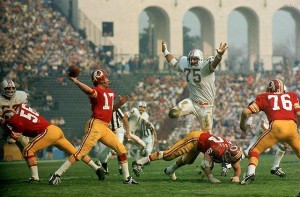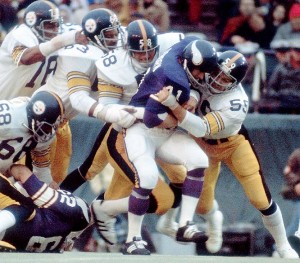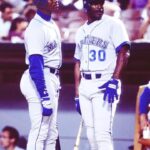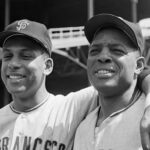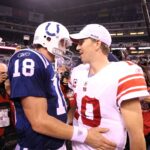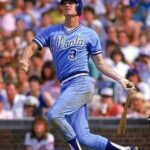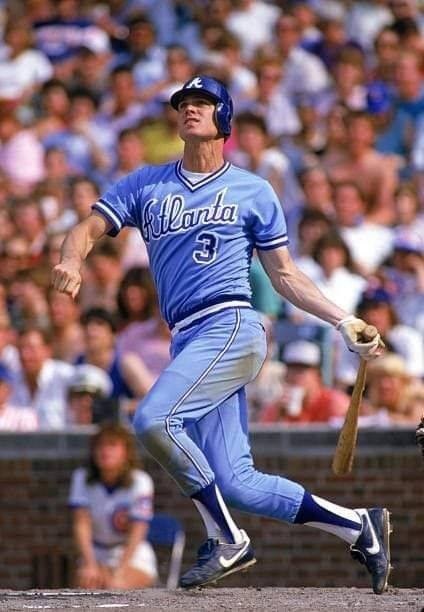25 Most Famous NFL Group Nicknames
With incoming rookie defensive tackle Nick Fairley joining fellow defensive tackle Ndamukong Suh and defensive end Kyle Vanden Bosch, Detroit Lions head coach Jim Schwartz decided to give his defensive line a nickname.
After interacting with his followers on Twitter, Schwartz chose the nickname “Silver Crush”.
Whether this nickname will stick or become well-known to NFL fans, will depend on how successful the line is and if the Lions begin to win, but the quest for Detroit’s defensive line to have a nickname to inspire me to look back at other memorable NFL group nicknames.
After weeks of research, I have come up with the 25 Most Famous NFL Group Nicknames.
These are nicknames to describe a certain group of players (ex. The Washington Redskins receivers) or a specific season (the 1980 Cleveland Browns).
Plus, the nickname cannot be derogatory such as the “Ain’ts”.
With that in mind, here are the 25 Most Famous NFL Group Nicknames.
25. Sack Pack (Baltimore Colts)
While it featured no Hall-of-Famers, this front four helped lead the Baltimore Colts to a renaissance in the mid-1970s.
Mike Barnes, Fred Cook, John Dutton, and Jon Ehrmann combined for 162 quarterback sacks in three seasons as the Colts won the AFC East in 1975, 76, and 77.
24. Crunch Bunch (New York Giants)
In 1981, rookie Lawrence Taylor joined veteran linebackers Harry Carson, Brian Kelley, and Brad Van Pelt to form the “Crunch Bunch” and helped the Giants to their first playoff berth in 18 years.
The group stayed together for two more seasons until Kelley and Van Pelt both retired.
23. Three Amigos (Denver Broncos)
Following their trip to Super Bowl XXI in 1987, the Denver Broncos used their first round draft pick to select rookie wide receiver Ricky Nattiel.
Nattiel joined Vance Johnson and Mark Jackson, to form the “Three Amigos” and be the primary targets for quarterback John Elway.
For the next five seasons, the “Three Amigos” combined for 572 receptions totaling 8,865 yards and 49 touchdowns to help Elway and the Broncos to three playoff appearances and two more trips to the Super Bowl.
22. Grits Blitz (Atlanta Falcons)
Many NFL fans will be surprised to know that the ’77 Falcons defense allowed the fewest points in a 14-game season.
Under a scheme that had as many as nine players blitzing on every play, the “Grits Blitz” allowed only 129 points in 14 games, averaging just a little over 9 points per game.
21. Dome Patrol (New Orleans Saints)
Rickey Jackson, Vaughn Johnson, Sam Mills, and Pat Swilling patrolled the Louisiana Superdome for the New Orleans Saints during the late 1980s and the early 1990s.
The “Dome Patrol” lead the Saints to their first playoff appearance in 1987 and then three straight playoff appearances from 1990-1992 as the Saints’ defense gave up the fewest points in the NFL in 1991 and 1992.
But the biggest achievement might have been all four linebackers being named to the Pro Bowl in 1992.
20. Marks Brothers (Miami Dolphins)
Mark Clayton and Mark Duper were the primary targets for Dolphins quarterback Dan Marino during the first 10 seasons of his Hall-of-Fame career.
From 1983 through 1992, the two receivers combined for 1,061 catches totaling 17, 512 yards and 140 touchdowns.
19. Big Blue Wrecking Crew (New York Giants)
Following the retirements of Brad Van Pelt and Brian Kelley, linebackers Lawrence Taylor and Harry Carson helped form the “Big Blue Wrecking Crew”, the defensive unit for the New York Giants under head coach Bill Parcells.
From 1984 through 1990, the defense helped the Giants to six winning seasons, five playoff appearances, and two Super Bowl championships.
Taken from the name of running back Jamal Anderson’s touchdown celebration, the “Dirty Birds” propelled the Falcons to their first and so far only Super Bowl as the team went 14-2 in the regular season, then upset the heavily favored Minnesota Vikings in the NFC Championship Game
17. Fun Bunch (Washington Redskins)
This group is credited with the first choreographed team celebration back in the 1982 playoffs as the Redskins’ wide receivers and tight ends gathered in the end zone, and then jumped out together to give each other a high-five.
This celebration was also used in the Redskins’ Super Bowl XVII victory over the Miami Dolphins and remained a part of the Redskins’ repertoire until it was banned in 1984.
A sub-group of the “Fun Bunch” was the “Smurfs”, three receivers (Charlie Brown, Alvin Garrett, and Virgil Sealy), who were all under 5’ 10”.
16. Killer B’s (Miami Dolphins)
The ’82 Dolphins defense featured six starters that had their last names begin with the letter “B”; Bob Baumhower, Doug Betters, Kim Bokamper, Bob Brudzinski, and the Blackwood brothers (Glenn and Lyle).
The “Killer B’s” stung the rest of the NFL as they allowed only 131 points in the strike-shortened regular season and then only allowed 26 points in three playoff victories to lead the Dolphins to Super Bowl XVII, where they fell to the Washington Redskins.
15. Orange Crush (Denver Broncos)
Named after the soda that was based in Denver, the “Orange Crush” defense was the #1 defense against the run and held opponents to just under 11 points per game to lead the Broncos to a surprising run to Super Bowl XII in 1977.
14. Million Dollar Backfield (San Francisco 49ers)
During the mid-1950s, the 49ers had a backfield that featured four future Hall-of-Famers: quarterback Y.A. Tittle, halfback Hugh McElhenny, and fullbacks Joe Perry and John Henry Johnson.
The trio of running backs helped the 49ers lead the NFL in rushing in 1954 with 2, 498 rushing yards.
The backfield stayed together for two more seasons before Johnson was traded to the Detroit Lions.
13. Doomsday (Dallas Cowboys)
While the nickname applied to the Cowboys defense during the 1970s, there are two different generations of the “Doomsday” Defense.
“Doomsday I” featured “Mr. Cowboy” Bob Lilly, Mel Renfro, and Chuck Howley from 1966-1974, and helped the Cowboys to two Super Bowls, winning Super Bowl VI with a 24-3 victory, becoming the only defense not to allow a touchdown in a Super Bowl.
“Doomsday II” was even more successful was it propelled the Cowboys to three Super Bowls in four years, winning Super Bowl XII thanks game co-MVPs Harvey Martin and Randy White.
The “Sack Exchange” helped to four playoff appearances in six years, including a trip to the 1982 AFC Championship Game.
Also, Gastineau set the then-NFL record for most quarterback sacks in a season with 22 in the 1984 season.
11. Electric Company (Buffalo Bills)
O.J. Simpson came up with this nickname for his offensive line because they “turned on the juice”.
The “Electric Company” did turn on the juice for Simpson as he won the NFL’s leading rusher four times in five seasons, including his 2,003 yard season in 1973.
Simpson also scored a then-record 23 touchdowns in the 1975 season, and rushed for over 200 yards six teams in his career, another NFL record.
10. Kardiac Kids (Cleveland Browns)
The 1980 Cleveland Browns were known for their heart-stopping finishes as 12 of their 16 games were decided by seven points or less, with Cleveland winning nine of them to bounce back from a 0-2 start to finish the regular season 11-5 and win the AFC Central.
But the “Kardiac Kids” magical season ended in heartbreaking fashion on the infamous “Red Right 88”, Brian Sipe being intercepted by Raiders defensive back Mike Davis in the end zone with 41 seconds left to hand the Browns a 14-12 defeat.
9. Air Coryell (San Diego Chargers)
Don Coryell revolutized the passing game when he was head coach of the San Diego Chargers from 1978-1986.
With quarterback Dan Fouts at the helm of “Air Coryell”, the Chargers led the NFL in passing yards from 1978 through 1983 as Fouts threw for more than 24,000 yards by throwing to targets such as Charlie Joiner, Wes Chandler, John Jefferson, and tight end Kellen Winslow.
During Coryell’s reign as head coach, the Chargers made the playoffs four straight years (79-82), won three straight AFC West titles, and played in the AFC Championship Game twice, but failed to reach the Super Bowl.
“Air Coryell” is considered as the inspiration for the offense with the eighth most memorable nickname.
8. Greatest Show on Turf (St. Louis Rams)
From 1999 through 2001, the St. Louis Rams had one of the most explosive offenses in NFL history.
Led by quarterback Kurt Warner, running back Marshall Faulk, and wide receivers Isaac Bruce and Torry Holt, the Rams scored over 500 points in three straight seasons and leading St. Louis to two Super Bowl appearances in 1999 and 2001, with a win in Super Bowl XXXIV over the Tennessee Titans.
7. Over the Hill Gang (Washington Redskins)
George Allen helped lead a revival of the Redskins in the 1970s, by going to a mostly veteran team and trading almost all of the team’s draft picks each season in the seven years in which Allen coached the team.
From 1971 through 1977, the Redskins had seven winning seasons, made the playoffs five times, and won the 1972 NFC Championship for a trip to Super Bowl VII, where they lost to the team with the #6 nickname.
6. No-Name Defense (Miami Dolphins)
In an interview before Super Bowl VI, Dallas Cowboys head coach Tom Landry praised his opponent, the Miami Dolphins and their defense, but said he could not remember the names of the defensive players.
This led to the creation of the “No-Name” Defense, a defense that helped the Dolphins to three straight Super Bowls in the early 1970s.
Following Miami’s loss in VI to the Cowboys, the “No-Names” were the top defense for the next two seasons as the Dolphins won back-to-back Super Bowls and went 17-0 in 1972, the only undefeated season in the Super Bowl era.
5. Hogs (Washington Redskins)
During the Redskins’ training camp in 1982, offensive line coach Joe Bugel told his lineman “Okay, you hogs. Let’s get running down there”.
The word “Hogs” stuck with the offensive line through the rest of the 1982 season and into the early 1990s as the Redskins would win go on to four Super Bowls in 10 years, winning three of them.
Members of the “Hogs” included Hall-of-Famer Russ Grimm, Joe Jacoby, Mark May, Jeff Bostic, Mark Schlereth and Jim Lachey, and also helped inspired the Redskins fan group “the Hogettes”.
4. Fearsome Foursome (Los Angeles Rams)
This nickname actually originated with the New York Giants defensive line of the 1950s and was also used to describe the San Diego Chargers and Detroit Lions’ front four of the early 1960s.
But when NFL fans think about the “Fearsome Foursome”, they think of the Rams defensive line of the 1960s that featured Deacon Jones, Merlin Olsen, Rosey Grier, and Lamar Lundy, who helped the Rams from the bottom of the league and into a power in the late 60s.
Olsen and Jones would be inducted into the Hall-of-Fame.
3. Purple People Eaters (Minnesota Vikings)
Getting its nickname from a Sheb Wooley song from 1958, the “Purple People Eaters” were one of the greatest defensive lines of all time for the Minnesota Vikings.
During the late 1960s and most of the 1970s, the Vikings’ defensive line of Carl Eller, Alan Page, Jim Marshall, and Gary Larsen (later replaced by Doug Sutherland) helped Minnesota to nine division titles in 10 years and four trips to the Super Bowl.
Eller and Page are in the Hall-of-Fame, while Marshall started 282 consecutive games, a record that stood for nearly 30 years after his retirement.
2. Monsters of the Midway (Chicago Bears)
This nickname originated in the 1940s after the Bears won back-to-back NFL titles in 1940 and 1941, which included a 73-0 rout of the Washington Redskins in the 1940 NFL Championship Game.
Chicago would win two more NFL titles in the 1940s (1943 and 46) for a total of four championships in seven years.
The nickname was revived in 1985 when the Bears “46” defense lead Chicago to a 18-1 season and a Super Bowl title.
1. Steel Curtain (Pittsburgh Steelers)
Originally used to describe the defense line, the nickname “Steel Curtain” has since been applied to the entire defensive unit, perhaps the greatest defense in NFL history.
During the 1970s, the “Steel Curtain” ranked 1st or 2nd in points allowed in five seasons, as it helped the Steelers to four Super Bowl titles in six years.
The “Curtain” only gave up 195 points in 1978, the third-fewest in league history, despite some rule changes that were supposed to cut down on the defense’s dominance, as the Steelers went to a 14-2 season and won their third Super Bowl title.
But the best defense for the “Steel Curtain” was in 1976, when the Steelers didn’t the Super Bowl, as the defense allowed only 138 points in 14 games, and posted five shutouts, including three in a row at one point.
Four players from the defense; Mel Blount, Joe Greene, Jack Ham, and Jack Lambert are enshrined in the Hall-of-Fame.
